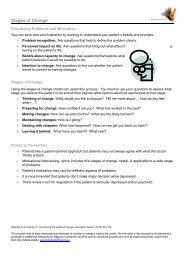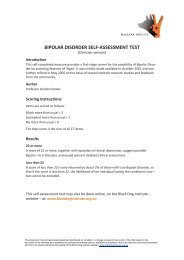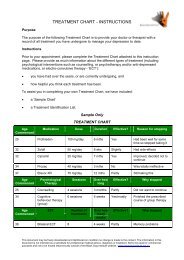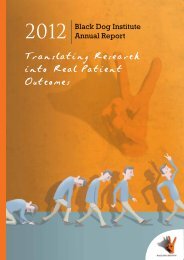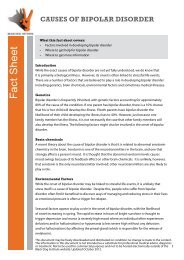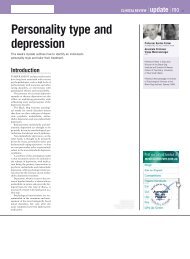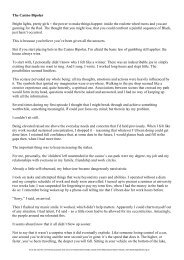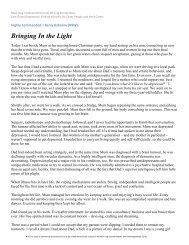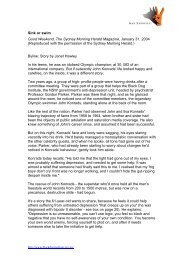Transcript: Exercise Your Mood Launch - Black Dog Institute
Transcript: Exercise Your Mood Launch - Black Dog Institute
Transcript: Exercise Your Mood Launch - Black Dog Institute
Create successful ePaper yourself
Turn your PDF publications into a flip-book with our unique Google optimized e-Paper software.
<strong>Exercise</strong> <strong>Launch</strong> <strong>Transcript</strong>Professor Gordon Parker: Welcome to the launch of the <strong>Institute</strong>’s ‘<strong>Exercise</strong> the <strong>Mood</strong>’subtitled, ‘<strong>Exercise</strong> as a Treatment for Depression’. I’m wearing the only sporting tie I could find, notmuch exercise in swinging a golf club, but maybe David will challenge that in a while. We certainly hopethat this will be an important step towards raising awareness of the role of exercise in managingdepression, where it can sometimes be a primary treatment for many people and certainly for many ahuge component within the management plan.I would very much like to thank the funders of the program, and that is the Roth Charitable Foundationwhich was established by Henry Roth and it distributes much needed funding to hospitals, educationalestablishments, research institutes and welfare groups, and as I said, their generous donation hasallowed this program to be developed. I would also like to thank the UNSW Lifestyle Clinic forcollaborating with us in the development of the program, and for its director, Chris Tzar, who we’ll hearfrom in a while, who’s an accredited exercise physiologist, a national board member of the AustralianAssociation for <strong>Exercise</strong> and Sports Science and as I said, he’ll be talking shortly on the role of exercisephysiologists. I would also like to welcome our VIP guests here. The first is Graeme Cowan, who’sauthor of ‘Back From the Brink’ and ‘Back From the Brink Too’ and he’ll say a few words about the roleof exercise in recovering from depression he’s experienced himself. We also have three distinguished,famous and extraordinary sportsmen here, John Konrads, who at one stage had every world record from200m to 1500m in the swimming pool and he’s a member of the <strong>Black</strong> <strong>Dog</strong> <strong>Institute</strong> board and hascontributed to helping so many people over time. David Spindler, who is a golfer, but also professionalcaddy and he was most recently involved in the return of Tiger Woods and he might talk about theexercise he got involved in trying to chase after the crowd and stop his golfer from being distracted, andhe’s off shortly to go to Japan. And Brendan Capell, who is doing the most extraordinary set of activitiesas a long distance swimmer. For any of us who might think of swimming a distance, the English channelwould seem almost mission impossible, he not only wishes to swim it, but to race it, and will be takingpart in this extraordinary event. I’d also like to welcome Janet Benson, who’s the senior clinicalpsychologist from the Sydney West Area Health Service Depression Management Program, who assistedin putting together some of the components today. And I’d also like to thank Matthew Johnstone,author of ‘I Had a <strong>Black</strong> <strong>Dog</strong>’ and ‘Living with a <strong>Black</strong> <strong>Dog</strong>’, who’s done the wonderful graphic that yousee for this program, which is multi‐layered in not only suggesting ‘exercise’ but ‘exorcise’ in terms ofaddressing depression. My final welcome and introduction is to Joanna Crawford, who is a researchpsychologist and clinical psychologist who has really worked so hard at pulling together this programover the last few months and she’s going to give the first presentation. Now, to Joanna...Click here to see Joanna’s presentationDavid Tzar: You may be wondering, what is an exercise physiologist? In essence, exercisephysiology is an emerging profession and they’re playing a greater role in the health system andmoreover in the health of all Australians. Particularly in the past 10‐15 years, what we’ve seen is an
abundance of evidence that shows that exercise can work like medicine in the treatment of variousconditions. An explanation of how it works like medicine is that there is a dose‐response type effect, sothere’s an ideal type of exercise, an ideal frequency and intensity that it should be performed to helpassist in the management of a particular condition. We know that it also is an integral therapy in thetreatment of the majority of chronic conditions in Australia, ranging from diabetes, hypertension,osteoporosis, osteo‐arthritis, and of course depression, as you will see a little bit later with some of ourspeakers who will attest to its benefits and effects. Another reason for the emerging role of exercisephysiologists in the health system is because of inactivity, so the effects of being sedentary, and we nowknow that in terms of lifestyle related factors, it’s the second largest cause for chronic disease inAustralia behind smoking. So, it’s kind of telling us that inactivity levels are kind of as high as they canget, and of course we know that it accounts for about 25% of all preventable deaths, that’s more thanalcohol and motor vehicle accidents combined, so it’s something that warrants specific attention. Sowhat do we do in essence? I guess the best way to sum it up is to say that we provide self‐managementsupport, supporting people to manage themselves better and we can do that for prevention of amedical issue or for the management of an existing or established medical condition that ranges fromchronic disease to depression. Probably about 85% of the patients that are treated do a home‐basedexercise program, so we need to dispel a few misconceptions that are associated with our services: wedon’t necessarily work in a gymnasium setting we do what suits the preference of people, so peopleoften want to do more activity or do an exercise program but they don’ necessarily want to visit agymnasium facility. We have to develop a program that will suit people’s needs and get them to sustainit in the long term, so they’re some of the challenges we face. It’s not a matter of designing the perfectexercise program, it’s about the strategies that we implement to get people to sustain and maintain itfor the long term. As we know, the first 12 weeks are the toughest, this is where we see people whoundertake an exercise program from a sedentary position, we see about an 85% drop out rate in thatperiod. So, how can we overcome a lot of the barriers associated with physical activity and exercise.I’ve put this up to give you an idea of a typical sort of treatment with an EP, so we may see anyonebetween 2 and 5 consultations over the 12 week period, depending on whether the person presentswith more motivational issues or movement limitations if they have osteo‐arthritis and so forth, wemight see them for a higher frequency, but each consultation is addressing a lot of the barriers and theissues that present because up until they’ve exercised, they are all perceived barriers, you don’t knowwhat issues they’re going to be confronted with. So, this is really the critical element in succeeding ingetting them more active. There is support out there for people to be able to access these services,there are rebates that are available through the Medicare system, so your GP can draft you an enhancedprimary care plan and that includes conditions like depression, and that’s where the bulk of our patientsget their rebates from. DVA also provides rebates for people who hold a DVA card, and all the majorprivate health funds provide rebates as well, for both individual as well as group programs.Where do I find an exercise physiologist? Well, there are over 1,200 practising exercise physiologistsnationally and there is a search directory on this website: www.aaess.com.au. It will enable you toaccess an accredited exercise physiologist in your area or talk to your GP about an EP that you couldwork with because EPs often work in a multi‐disciplinary model, they consult with doctors or treatingpsychologists to make sure they’re going to get the best outcome. Multi‐disciplinary care is not just a
case of a person seeing several health professionals, it’s about those health professionals workingtogether to get the best outcome for their patients.Incidentally, the training that an exercise physiologist undergoes is a 4‐year degree in exercise scienceplus 500 hours of clinical placement, so they are qualified to manage people with certain needs and alsoto implement a lot of the counselling strategies that are required to engage a person to maintain theirexercise program.Graeme Cowan: Since I was 21 I’ve had 5 major episodes of depression, and the last was by farthe worst. It lasted for 5 years and I tried lots and lots of different medications and ECT and all sorts ofthings, kinesiology, acupuncture, etc. Finally, I ended up in Northside Clinic, I was there for about 9weeks, I came out and I was feeling a little better but not that much better, but I attended an outpatientdepression management program and they encouraged us, there was a group of about 6 of us who hadcome out of hospital and a couple of psychologists. They asked us to set short term, weekly goalsaround exercise and contact with family and friends, and for those of you who have been depressed youwould know that those are the two things are the last thing you really feel like. But, I think there wassomething about being a group situation and committing to do it and then also scheduling when youwere going to do it, and so I began to walk quite regularly, about 15 minutes a day and probably overabout 2‐3 weeks I built that up to 30 minutes and then 45 minutes and continued to do that. It was acentral part of my recovery, after trying all of those things it wasn’t the only component in my recoverybut it was a really, really important component. Funnily enough ,for the research that I did for my firstbook ‘Back From the Brink’ , I asked 350 people what they found best or most effective in overcomingdepression and exercise was nominated as the number one thing, it was nominated ahead ofpsychological counselling, medication, even the support of family and friends, it was nominated as thenumber one thing. I have first‐hand experience of the benefits and the feedback from those 350 peoplealso suggests that they found it to be a wonderful strategy and it’s free!Professor Gordon Parker puts some questions to the panelProfessor Parker: First to Brendan Capell, you swim 15 ‐17 km a day, that’s about 300 laps of anOlympic pool, which would probably be more than all of us combined would do in a year. I guess thefirst question, what goes through your mind when you’re swimming? Then the second question, whatdo you think are the benefits of exercise on mood states, particularly for swimmers?Brendan Capell: I’ll answer the second question first. If you’ve had a rough day it can definitelyreduce stress and improve your mood, if you get in the pool and you swim those 140 laps or more andyou do a good job of it, I usually feel like I’ve achieved something, it’s a challenge first and you set goalsand if you reach that challenge you feel a sense of achievement and it improves your self‐esteem. I
definitely think that exercise, for me, is a mood improver. What goes through my mind? As the themetoday seems to be, get your friends involved in the exercise as well, , I’ve got a very good squad that Ido this with, we’ve got some very good swimmers in our squad, and to do it in a group environmentyou’re always having fun and it’s just a lifestyle thing for me, more than anything. My training regime ispretty intensive, I train 10 times a week in the water and then I do 3 dry‐land sessions as well.Professor Parker: A final question, in terms of this big race across the channel, what are yougoing to be thinking about and how competitive will it actually be? I mean, obviously there’s going to bea dilemma, you’re all in it together and yet at the same time this is a race.Brendan Capell: It’s going to be very competitive, they’ve picked the best 6 guys in the world atthe moment but at the same time it’s going to be very exciting – normally it’s a solo crossing and to havea format where there’s six guys racing, I’m sure I’ll be thinking ‘we’re all in this pain together’ so it willdefinitely be exciting and an achievement.Professor Parker: Thanks Brendan. Keeping up the swimming theme, we’ll move along to JohnKonrads. John, what are your comments and thoughts on exercise on swimming during your heydayand subsequently as a coach, and in terms of other aspects of exercise?John Konrads: I find the correlation between mood and exercise and as for most people,motivation is a big issue. I think there are two important points about exercise: the first is ‘a little bitvery often is better than a big bit infrequently’. The second one is, as Brendan mentioned, and that issomebody to motivate you, because as we know we can’t manage depression by ourselves and we can’tmanage exercise by ourselves either. I think one of the favourable things in my life is that I’ve alwaysbeen exercising and, as with most swimmers, I stayed out of the water for a couple of decades afterbeing overdosed as a kid, but then I did jogging, I picked up tennis, I went to the gym, so I’ve always heldphysical fitness as a very important part of my life. Just a quick question to Brendan: When you get toCalais, how do you do a tumble turn on the sand for the return trip?Brendan Capell: I don’t plan on doing one!!Professor Parker: Good one, John. We’ll turn to David Spindler, golf is not your only sportingactivity, you also cycle?David Spindler: Yes I do. For me, the last thing I want to do when I get home from work is to goback to my workplace and play golf. So I need something totally different. As I was young I used to beatballs to get outside of my own head, but now I do that by cycling. I’ve struggled a little bit because whenI’m depressed I do exactly what I shouldn’t do which is to go out and get hammered and it has taken mea long time to realise that that’s not the right thing to do. I must be getting older.
Professor Parker: Do you see that a depressive symptom or do you see it as an attempt tooverride the depression?David Spindler: I think it’s a direct result of me being too much of a perfectionist, so I don’t wantto see myself sliding so I go out and try to do everything I possibly can not to get into that state becauseI realise that once I’m there, I’m there for a very long time. I’m bipolar so I hardly ever go straight down,I’m usually high before I go low, so I usually start riding when I’m high.Professor Parker: So the riding will bring you down from the high, exhaust the high, or will it revyou up even more?David Spindler: Well, that’s a good question because when I’m on a high, I do absolutelyeverything to stay there, and I think the cycling does a bit to try to keep me there and get those positiveendorphins or whatever you’d like to call them to keep that high and the fact that I do that too muchsends me down. So, as John said, I need to get a little bit a lot... maybe I need to grow up!Professor Parker: When you look at golfers, it doesn’t always look like they’re benefiting fromexercise, so is there a lot of exercise involved in golf?David: There’s a lot more now than what there used to be. When I first went out to caddie on a tour wedidn’t have a fitness trailer or anything and now we’ve got two semi‐trailers just for fitness. So, now it’sbecoming more of a sport and less of a past time that you can make a lot of money in. We do a lot ofwalking, as a caddie we do about 16km a day and it’s not just the four days of the tournament, we haveto do a practice run on the Tuesday and then we do a pro‐am format on the Wednesday and then goaround and do an actual tournament. As a caddie we have to do all of those plus our work to map thecourse and figure out how we’re actually going to play the game, so we do a lot more work than theactual golfers do, we just don’t tell them that.Professor Parker: Plus you carry those enormous bags.David Spindler: Yes, they’re about 25kg.Professor Parker:: As I mentioned in the introduction, you were actually caddying for theAustralian golfer at a competition about 4 or 5 weeks ago when Tiger Woods came back following hissporting injury and it was chaos, would you like to briefly tell people about the chaotic environment thatyou’ve had to deal with?David Spindler: Well, I’ve had a bit of a tough time, I’ve sort of had a really bad depressiveepisode, I was off work for 18 months, and my first two weeks back were a quite subdued 2tournaments in Australia, and then Brendan said we’re going to go and play the Accenture Match Playand we’re flying straight to America and I really shouldn’t have done it but I did, trying to get out there
and unfortunately we drew Tiger Woods as our first round. So yeah, we had about 50 million peopleagainst us pretty much. So Tiger would play a shot and then everyone would move because no‐onewould care what we did, so I actually said to Brendan “Let’s use this against him” so if we play a greatshot then he now has to have the pressure on him to play a good shot as well. So it was sort of a reversepsychology thing. I had a bit of a high because of that, which is not a bad thing after 18 months of adepressive episode.Professor Parker: And David you’re off to Japan shortly?David: Yes, I’ve got three more weeks here.Professor Parker: We hope that goes well. Thanks for joining us and thanks to the othermembers of the panel. We’ll now take some questions from the audience.Audience member: What is the interval generally between the commencement of exercise andthe benefits?Joanna Crawford: That’s a good question. Most of the exercise programs that have been shownin randomised‐controlled trials to improve clinical depression have ranged from 8 to 16 weeks. Onestudy found that exercising regularly took longer to improve mood than an antidepressant but wasequally effective at the end of that 16 weeks. I think that’s an important thing to know becausesometimes people might try it a couple of times or a week and think that they’re still feeling bad sothere’s not much point continuing , but if they know that if they stick with it for a long time, just littlebits for a long time like our speakers said, say walking briskly for ½ hour each day and sticking to that for11‐16 weeks then there can be a significant reduction in clinical depression.John Konrads: There can also be an immediate payback because when you get back from the ½hour walk you think ‘gee I’m glad I did that’ so there is an immediate positive feedback, but then ofcourse you’ve got to get ball rolling again.Joanna Crawford: Actually, that’s a good point John. The research, as well as most people’sexperience, shows us that after just one bout of exercise people can have a lift in mood, but that liftdoesn’t necessarily stay there. So, on the one hand we have the immediate lift in mood and animmediate reduction in anxiety after a single session of exercise, but then to really reduce clinicaldepression in a more long‐lasting way that exercise needs to be kept up for at least a few months.John Konrads: I’d like to make another comment about swimming. Just briefly, swimming isrecognised as a boring sport because you can’t talk to anybody and you can’t see much, but forsomeone who is experiencing depression it’s almost meditative, we count our strokes it’s almost likemediation, 1,2,3,4... and it’s a way of almost blanking out and getting in the observer’s position inBuddhism.
Audience member: What’s the difference between what exercise physiologists do and whatphysiotherapists do?Chris Tzar: EPs in essence focus on active based therapy or exercise therapy for people with a rangeof medical issues, physiotherapists generally provide manual, passive or manipulative therapy and focuson muscular‐skeletal disorders, but there’s an element of crossover and certainly a physiotherapist withan interest in exercise therapy and particularly the management of depression would also be someonewho could amply manage someone with depression.Audience member: When people are depressed, motivation is a major issue, so if takes maybe16 weeks for the benefits to flow on how do you keep them motivated to get to that point?Chris Tzar: There are a number of strategies that we implement. But the first thing is that peoplewith depression don’t necessarily present with any more barriers than your average person who’sundertaking an exercise program from a sedentary lifestyle. What it does warrant is certainconsideration for the effects of depression, so in a general sense, most of the patients we consult wework together with their treating GP or their psychologist so that we can make sure that reinforcing oneanother’s message, it’s really about the left hand knowing what the right hand’s doing, so not tocontradict the treatment that the psychologist might be propelling. The strategies we implement areprimarily behaviour change strategies, we don’t do clinical counselling, but we certainly use strategies toassist a person to change their behaviours and lifestyle. So, it can incorporate developing motivationalelements, development of self‐efficacy which can often be a barrier to sustaining exercise, goal settingstrategies and other strategies that enhance compliance. I have to clarify, that figure I mentioned aboutthe 80% drop out rate, that’s for people who are unmanaged or unsupported, but that does represent alot people. Having support makes a lot of difference.Audience member: How much difference?Chris Tzar: There have been studies across different chronic disease states and certainly you canreverse the figures, so from an 80% drop out rate to a 20% drop out rate. We’re talking 12 months andbeyond, so it certainly makes a difference. You’re never going to get a 100% compliance rate, butcertainly it’s about shifting the majority of those people. And often the barriers are small things thatcould have been dissolved had anyone identified them and work together with strategies to overcomethem.David Spindler: I think that the point you were making before about needing a support networkto do the exercise is a huge thing. If you try to go and do it yourself you’ll find that when you’re startingto get depressed you actually need someone to come to you and motivate you. I like to say that whenyou’re depressed you can take a million sideway steps, just don’t make one backwards.
Audience member: What is the response from depressed people when faced with the messageto exercise. Perhaps they think that they need something more than just exercise.Professor Parker: I don’t think there’s any generalisation, I think it’s horse for courses. Thereare some people that have such profound melancholic depression that they can’t lift their head off thepillow and I think it would be quite inappropriate at that stage to tell someone that they must exercise.When the person is better to some degree, if they start exercising then they can do more and theirmood state improves. For people with non‐melancholic depression which are less biological disorders,then I think there are quite different mechanisms and therefore the lack of energy that is in the othergroup is not so much of a problem. I also think the answer, looking at why people do it and whatbenefits they find, as Graeme said his study of 350 yields pretty similar results to the study that Jo and Idid of 3,000 people, basically exercise came out as effective as the best antidepressant. Now it wouldbe very easy to say, well therefore exercise equals good antidepressants, but I think that’s facile becausethey’re two worlds. One is the antidepressant drug is dealing with the biological issues, once they’reunder reasonable control then what happens with people who are going to manage their mood disorderwell over time, is that they want to own it, they want to own their improvement, and therefore thenthey start to minimise the antidepressant drug, they take that as a base from which to move on. Theother thing that I would like to quickly comment on is that we used to think that exercise just merely gotthe endorphins going, but in the last few years we’ve reached a much wider perspective and so it’s notjust exercise but it’s also getting outdoors and getting exposure to sunlight which has effects via thepineal gland being stimulated and melatonin and so on and so forth and there are a whole series ofcascading biological factors that are making this a very rich field.Matthew Johnstone: Has there been any research into what exercise is better, like isswimming more beneficial or yoga or karate..?Chris Tzar: There have been some studies that have looked at different types of activities, like yogafor instance and they found some mild benefits, but they weren’t as well controlled as some of the RCTswe’ve seen with cardiovascular exercise. What is interesting is that they have looked at resistance basedexercise which is a different type of energy system and activity to cardiovascular exercise, andparticularly in older adults with depression they found that it was very effective and they did look atdose response, they got people to exercise with 20‐30% of maximal effort versus maximal effort andcertainly there was a marked reduction in depression in those that did maximal effort strength training.We’re going to see a lot more of those now that all of the preliminary data has come about.Professor Parker: At the <strong>Institute</strong> we owe a lot to Winston Churchill who gave us the wonderful‘black dog’ concept and descriptor. Churchill was famous for not exercising, in fact he said “If you cansit, don’t stand and if you can lie down, don’t sit”, so it seems somewhat paradoxical that after a periodof time we’ve come to appreciate that this was one area the Churchill didn’t have the best information.So thank you Jo, for putting all of this together, thank you Chris, thank you to our elite athletes andthank you to all of you for coming along.




